Wakopak® Series for Amino Acid Analysis
Column for amino acid composition analysis "Wakopak® Wakosil®-PTC"
The column for amino acid composition analysis.
Free amino acids derivatized to PTC-amino acids are separated and analyzed by the gradient method, and analyze amino acid composition.
The free amino acids in a sample can be easily derivatized with a phenyl isothiocyanate (PITC) reagent to provide highly sensitive analysis of up to 1 pmol. In addition, amino acids can be released from samples such as proteins and peptides by hydrolysis with hydrochloric acid etc. and derivatized to PTC-amino acids for amino acid composition analysis of the sample.
Column for amino acid sequence analysis by the isocratic method "Wakopak® Wakosil PTH-II"
The column for primary structure analysis of proteins and peptides separates PTH-amino acids by the isocratic method.
A column is connected to the HPLC system of the protein sequencer, and separates the derivatized PTH-amino acids by Edman method.
Column for amino acid sequence analysis by the gradient method "Wakopak® Wakosil PTH-GR (S-PSQ)(for Gradient Elution)"
This column is for primary structure analysis of proteins and peptides, and separates PTH-amino acids by the gradient method.
HPLC or LC/MS column for amino acid analysis "Wakopak® Ultra APDS TAG®"
A UHPLC column optimized for analysis of derivatized amino acids using an Amino Acid Analysis Reagent (for LC/MS)(APDSTAG®).
Column for Amino Acid Composition Analysis
Wakopak® Wakosil®-PTC
This column analyzes amino acid composition by quantifying the more quantitative PTC- amino acids obtained by the PITC labeling method. Gradient analysis is performed using two types of dedicated eluents (PTC-Amino Acids Mobile Phase), A and B. This method does not require a dedicated instrument, because it is a linear gradient rather than a complex gradient elution method as before. Therefore, it can be analyzed on most gradient HPLC systems.
Features
- Linear gradient elution with a dedicated eluent
- Can be analyzed using a general-purpose HPLC system
- High sensitivity: analysis up to 1 pmol possible
- Small interlot difference and high reproducibility
Examples of simultaneous analysis of 17 types of PTC-amino acids
-
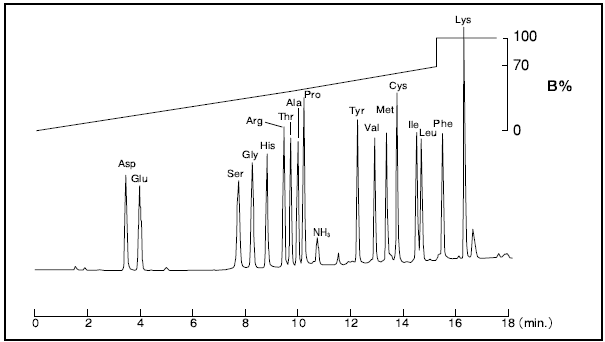
-
Column : Wakopak®Wakosil-PTC (4.0 mm x 200 mm) Eluent : A) PTC-Amino Acids Mobile Phase A
: B) PTC-Amino Acids Mobile Phase B
linear gradient
0 → 15 min. B 0 → 70%Flow Rate : 1.0 mL/min. at 40 ℃ Detection : UV 254 nm 0.32AUS Sample : PTC-amino Acids soln. (250 pmol)
Itsuo Inoue, Masami Fukumoto, Hitoshi Kamimori, Yoshitsugu Sakata, Shozo Shoji, Yukio Kubota: Biochemistry, 61, 1012 (1989).
PTC-amino acid derivatization method (method recommended by our company)
Derivatization procedure
- 1. Transfer 10 μL (25 nmol) each of the sample (approximately 10 pmol to 500 nmol) and the Amino Acids Mixture Standard Solution, Type H (25 nmol) to an Eppendorf tube.
- Dry under reduced pressure.
- Add 20 μL of a mixture of ethanol, purified water, and triethylamine (TEA) (2/2/1) and stir.
- Dry under reduced pressure.
- Add 20 μL of a mixture of ethanol, purified water, TEA, and PITC (7/1/1/1) and stir.
- Allow to react at room temperature for 20 minutes.
- Dry under reduced pressure.
- Store at -20℃ until analysis.
- Dissolve in PTC-Amino Acids Mobile Phase A and proceed with analysis.
* If the amino acid standard is dissolved in 1 mL and 10 μL of this solution is injected, the concentration is 250 pmol. Dissolve the sample in an appropriate quantity of PTC-Amino Acids Mobile Phase A and proceed with analysis.
-
Derivatization reaction

-
- When labeling samples, standard solutions must also be labeled at the same time, and quantitative calculation of amino acids in labeled samples must be performed using the analytical results of labeled standard solutions.
- Labeled samples can be used for approximately 3 months when stored frozen (-20°C) in a dry state. The solution in PTC-Amino Acids Mobile Phase A can be used for several days when stored frozen (-20°C).
Column for Amino Acid Sequence Analysis by the Isocratic Method
Wakopak® Wakosil PTH-II φ4.6 mm x 250 mm (S-PSQ)
This column is for primary structural analysis of proteins and peptides. PTH-amino acids generated by Edman degradation can be analyzed with high reproducibility and sensitivity under isocratic conditions using a Wakopak® Wakosil PTH-II φ4.6 mm × 250 mm (S-PSQ) and an eluate dedicated to PTH-amino acids (PTH-amino Acids Mobile Phase). It can also be applied to amino acids analysis in foods, drugs, media, and liquids by pretreatment appropriate for the sample.
Features
- Able to analyze 20 types of (PTH-derivatized) amino acids rapidly (within 25 minutes)
- Easy to operate (isocratic elution)
- Highly sensitive and reproducible analysis is possible
Examples of simultaneous analysis of 20 types of PTH- amino acids
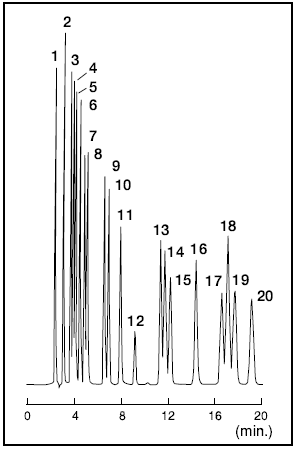
| Column | : Wakopak®Wakosil-PTH-II (4.6 mm x 250 mm) |
| Eluent | : PTH-amino Acids Mobile Phase |
| Flow Rate | : 1.0 mL/min. at 40℃ |
| Detection | : UV 269 nm |
| Sample | : 1) Asp 2) Glu 3) Asn 4) Gln 5) Ser 6) Thr 7) His 8) Gly 9) Ala 10) Tyr 11) Arg 12) Δ Thr 13) Met 14) Val 15) Pro 16) Trp 17) Phe 18) Lys 19) Ile 20) Leu |
Itsuo Inoue, Masami Fukumoto, Hitoshi Kamimori, Yoshitsugu Sakata, Naoki Morita, Takeshi Okumura: Biochemistry, 60, 876 (1988).
Column for Amino Acid Sequence Analysis by the Gradient Method
Wakopak® Wakosil PTH-GR (S-PSQ) (for Gradient Elution)
This is a dedicated column used in the PPSQ series (gradient system), a fully automated primary protein structure analyzer (Shimadzu Corporation).
In the PPSQ-50, a fully automated primary protein structure analyzer (Shimadzu Corporation), the analysis is performed using an HPLC column following Edman degradation. The sample volume to be injected into the analytical column is 50 μL.
The chromatogram for the gradient elution of a PTH-amino acid mixture standard (2 pmol) is shown in Fig 1 (a), and the chromatogram for the isocratic elution is shown in Fig 1 (b). Overall, gradient elution enables the detection of peaks that are about 3 to 5 times higher than those of isocratic elution, allowing the separation of highly hydrophobic amino acids.
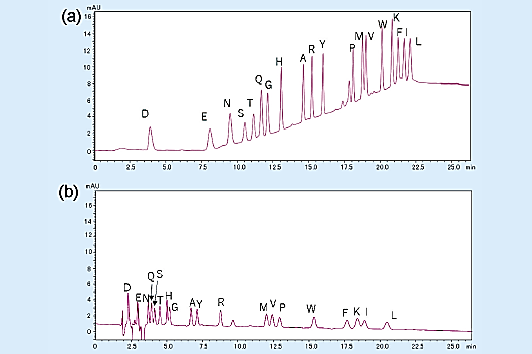
(a) gradient elution, (b) isocratic elution
In addition, the gradient elution enables PTH-amino acid separation and detection even when trace 500 fmol samples are analyzed and enables easy detection of increasing PTH-amino acids (Fig 2).
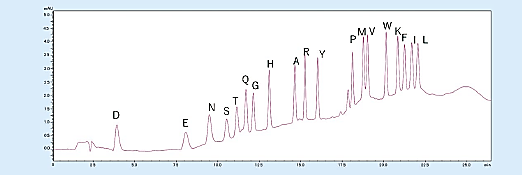
Example of Amino Acid Sequence and Composition Analysis of Reduced Lysozyme
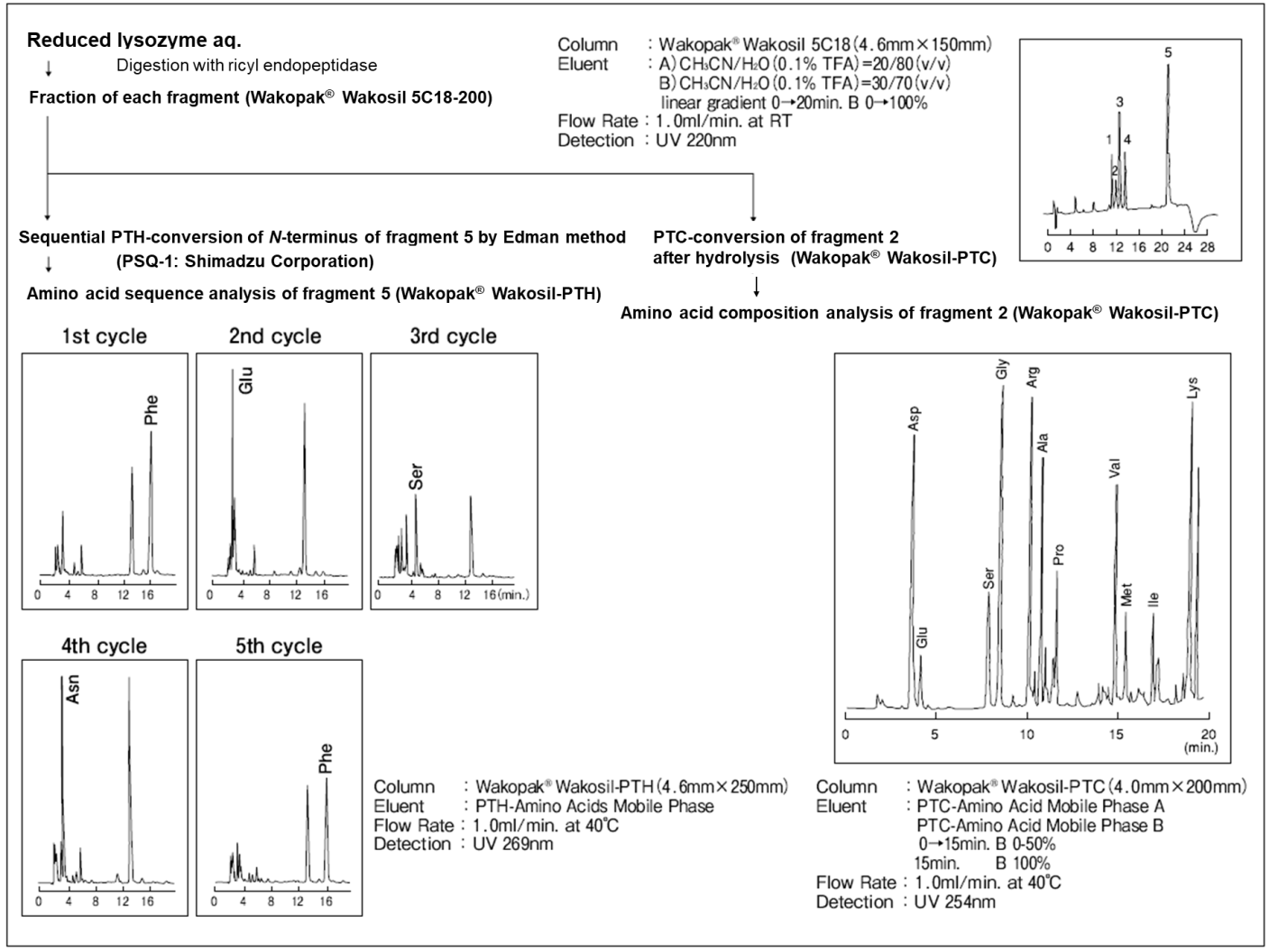
HPLC or LC/MS Column for Amino Acid Analysis
Wakopak® Ultra APDS TAG®
Wakopak® Ultra APDS TAG® is an UHPLC column optimal for analyzing derivatized amino acids witch are derivatized by Amino Acid Analysis Reagent (for LC/MS)(APDSTAG®).
Analysis example
-


Analysis Conditions
Column Wakopak® Ultra APDS TAG® Flow rate 0.3 mL/min. at 40 ℃ Detection MS/MS, ESI positive, MRM Eluent A APDSTAG Wako Eluent Eluent B 60% Acetonitrile
Gradient
Time (min) 0 0.05 1.7 1.71 4.95 5.95 5.96 6.7 6.71 12 B(%) 6 8 8 12 30 60 95 95 6 6 -
No. Amino acid Abbreviation Q1 Q3 1 2-Aminoethanol EtOHNH2 182.1 121.0 2 Glycine Gly 196.1 121.0 3 Sarcosine Sar 210.0 121.0 4 Alanine Ala 210.1 121.0 5 4-Aminobutyric acid GABA 224.1 121.0 6 3-Aminoisobutyric acid β-AiBA 224.0 121.0 7 2-Aminobutyric acid α-ABA 224.0 121.0 8 Serine Ser 226.1 121.0 9 Proline Pro 236.1 121.0 10 Valine Val 238.1 121.0 11 Threonine Thr 240.1 121.0 12 Taurine Tau 246.1 121.0 13 Hydroxyproline Hypro 252.1 121.0 14 Isoleucine Ile 252.1 121.0 15 Leucine Leu 252.1 121.0 16 Asparagine Asn 253.1 121.0 17 Aspartic acid Asp 254.1 121.0 18 Glutamine Gln 267.1 121.0 19 Glutamic acid Glu 268.1 121.0 20 Methionine Met 270.1 121.0 21 Histidine His 276.2 156.0 22 α-Aminoadipic acid α-AAA 282.1 121.0 23 Phenylalanine Phe 286.2 121.0 24 1-Methyl-L-histidine 1MeHis 290.2 170.0 25 3-Methyl-L-histidine 3MeHis 290.2 170.0 26 Arginine Arg 295.2 175.1 27 Citrulline Cit 296.3 121.0 28 Tyrosine Tyr 302.2 121.0 29 Tryptophan Trp 325.2 121.0 30 Carnosine Car 347.2 227.1 31 Anserine Ans 361.3 241.1 32 Ornithine Orn 373.5 121.0 33 Lysine Lys 387.5 147.0 34 5-Hydroxylysine HyLys 403.5 163.0 35 Cystathionine Cysthi 463.2 223.1 36 Cystine Cys2 481.2 121.0
Product List
- Open All
- Close All
Column for PTC-amino Acid Analysis
Eluent for PTC-amino Acid Analysis
Column for PTH-amino Acid Analysis (for Isocratic)
Eluent for PTH-amino Acid Analysis (for Isocratic)
Column for PTH-amino Acid Analysis (for Gradient)
Eluent for PTH-amino Acid Analysis (for Gradient)
APDS TAG® - Column for Amino Acid LC/MS Analysis
APDS TAG® - Eluent for Amino Acid LC/MS Analysis
For research use or further manufacturing use only. Not for use in diagnostic procedures.
Product content may differ from the actual image due to minor specification changes etc.
If the revision of product standards and packaging standards has been made, there is a case where the actual product specifications and images are different.



